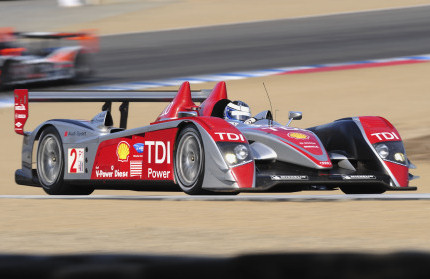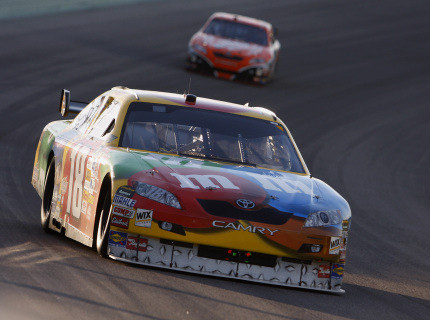The Way It Is/ A challenging new age arrives
by Gordon Kirby As we all know motor racing will suffer some difficult times over the next few years. Everyone is cutting back, trimming budgets and looking for new business models to suit the tough economic times. Each of NASCAR, Formula 1 and ALMS have felt the early tremors in recent weeks with substantial layoffs in NASCAR, Honda deciding to quit F1 and Audi restricting its racing program with the new R15 turbo diesel to only the Sebring 12 hours and Le Mans 24 hours. More of these things are likely to happen as NASCAR struggles with both the sad state of the Detroit auto industry and sharply declining ticket sales while other F1 teams like Toro Rosso may find F1 too rich for their blood in this day and age.
As we all know motor racing will suffer some difficult times over the next few years. Everyone is cutting back, trimming budgets and looking for new business models to suit the tough economic times. Each of NASCAR, Formula 1 and ALMS have felt the early tremors in recent weeks with substantial layoffs in NASCAR, Honda deciding to quit F1 and Audi restricting its racing program with the new R15 turbo diesel to only the Sebring 12 hours and Le Mans 24 hours. More of these things are likely to happen as NASCAR struggles with both the sad state of the Detroit auto industry and sharply declining ticket sales while other F1 teams like Toro Rosso may find F1 too rich for their blood in this day and age.
Depending on the length and depth of the recession, everyone--F1, NASCAR, ALMS, Euro LMS, Grand-Am, IRL, etc--will struggle to fill their fields and put on shows worth the price of admission. These are truly challenging times for all sanctioning bodies, tracks and teams as well as engineering and component suppliers--the entire industry, in fact.
All this comes at a time when many people believe racing as a whole has lost its way and become something different and less appealing than what it was for ninety or more years. I've railed against spec car racing and the damage it's doing to the sport yet in the current economic times the move to spec cars is likely to be a fait accompli as everyone searches for ways, mythical or not, to promote cuts in cost and 'inexpensive' racing.

© LAT USA
It's always been said that to succeed in controlling racing's technology game the sanctioning body has to be smarter than the teams. The FIA and NASCAR have made some serious attempts to tackle this riddle by hiring experienced racers for key technical or operational positions but the conventional wisdom is that a sanctioning body can't afford to pay the salary of such highly qualified individuals who are the kind of people who probably wouldn't survive, let alone thrive, in the bureaucratic environment of a sanctioning body. In the cold light of reality, both of those points probably are true.
I believe the best method of finding a new way forward for motor racing is to reflect on the past and the ninety-plus years of motor sport in which innovation was king and racing thrived on the next new concept. Developing new ideas and improving the breed were essential to the sport and there used to be as much interest in the latest Ferrari, Chaparral, Lotus, Eagle or McLaren as in who was best young driver or champion of the day.
Racing's great technology revolution lasted from the sport's creation at the beginning of the twentieth century through the century's dying years. It's deeply ironic that the world's sanctioning bodies reacted to the genius of guys like Colin Chapman, Jim Hall and Dan Gurney by banning every new idea or redefining it and drastically restricting future development. In the end, as people like Gurney and Hall have pointed out, we've wound up with a generally defined race car based on the Lotus 79 from thirty years ago. Any room for rethinking its basic elements have been bleached-out by the rulemakers in all forms of racing, F1 included. With the subsequent banning or restricting of things like active suspension, fully automatic transmissions and traction control it's become clear that in many ways technology has outstripped the sport.
So here's the challenge, exacerbated by today's economic conditions, for all of racing's major sanctioning bodies. Can any of them recreate or awaken motor racing's innovative soul and make the sport relevant in the race to develop the green elements that will comprise the car of the future? Or will the sport's sanctioning bodies continue on the path to being simply delivery vehicles for mere entertainment with the cars reduced to seriously restricted spec racers?

© Dyson Racing Mazda
In fact, those days have already arrived. As documented in this space and the pages of Motor Sport, America's role in developing front rank international drivers, cars and teams came to a grinding halt over the last twenty years. American racing today is more parochial than ever and it seems unlikely that we'll ever again see an American-designed and built car or team make a major mark on the sport.
Let's not forget that Penske Cars in the UK went out of business four years ago after building an impressive run of F1 and Indy cars for almost thirty years. A more important bellweather is All American Racers in California where a superb series of F1, Indy and GTP cars were designed and built over 34 years from 1966-'99. Today, AAR builds lightweight UAV components for the US military but its life as one of the world's great race car constructors came to an end in company with the last century.
Of course, Swift in California tried and failed in partnership with Newman/Haas at the turn of the century to build and race a successful Indy car while Champ Car's last year of life witnessed the fleeting appearance of the Georgia-built Panoz DP01 spec car. But with the IRL emerging as the 'winner' of the twelve-year civil war Indy car racing remains as a shadow of its former self with an unattractive, underperforming de facto Italo-Japanese spec car that's about as far as you can imagine from an Offenhauser, Chevrolet or Cosworth-powered Eagle from the sixties, seventies or eighties in full flight.
Last summer my colleague Michael Schmidt of Germany's Auto Motor und Sport magazine made a rare visit to an IRL race. "These cars look and sound twenty years out of date," Schmidt remarked as he shook his head in bewilderment. "They're terrible!" As I've written before in this space aesthetics count in motor racing, but many of today's categories, not only the IRL, have clearly lost the plot in this department, too.
With many teams in dire financial straits the IRL faces plenty of challenges with car counts next season. It's also going to be difficult for the IRL to launch a new formula in 2011 as the global financial crisis accentuates the results of American open-wheel racing's many lost years amid a gaping leadership vacuum. Tony George, Terry Angstad and the people on Sixteenth Street in Indianapolis have their work cut out for them.
After being hailed in recent years as American motor sport's breath of fresh air the ALMS also faces challenges with car counts and a general deflation in competition. Without Audi and the Penske Porsches the ALMS will feature Acura and Mazda in 2009 with two new Acura P1 cars run by Gil de Ferran's new team and Duncan Dayton's Highcroft Racing plus a single Acura P2 entry from Adrian Fernandez. Mazda hopes to step up to a new level of competitiveness with ALMS stalwart Rob Dyson who will run a pair of Lola-Mazdas

© LAT USA
The plight of the IRL and the ALMS also emphasizes American Honda's condundrum of trying to find an effective series in which to race and demonstrate its technical abilities. Over the past fifteen years American Honda has invested hugely in Honda Performance Development (HPD) in Santa Clarita. As the IRL debilitated into a spec car formula Honda and HPD diversified into the ALMS but now finds itself facing a similarly dwindling field of competitive manufacturers.
I can't see Honda ever making the move to NASCAR, particularly with Toyota solidly established in stock car racing. But over the next few years Honda will be compelled to make some hard-nosed assessments about what it's getting out of both its IRL and ALMS programs. Indeed, it's a sad comment on the state of the sport that there's no category, F1 included, where a manufacturer like Honda with a deep historic commitment to racing can't find a thriving forum to compete in and develop its products, engineers and engineering processes. Obviously, American Honda and HPD hope the ALMS will build on its best elements for a healthy future.
Meanwhile, Penske's switch to the Grand-Am will give the Daytona Prototype series a shot in the arm. The Grand-Am will be a little thinner than this year due to Detroit's cutbacks but most teams are continuing in 2009. Whether the series can draw serous crowds or media coverage beyond the Rolex 24 hours remains to be seen.
Equally interesting to watch over the coming years will be NASCAR's evolution. Clearly, NASCAR will have to find a way to wean itself from the failing Detroit auto industry. Jeff Gordon said last week that he'll take a pay cut to help Hendrick Motorsports stay competitive but with NASCAR banning testing at any of its active tracks the bigger teams are sure to benefit by testing whereever they can. Just as the 'Car of Tomorow' helped the bigger teams like Hendrick get a leg up on everyone else the testing ban will help them too.
Meanwhile, it seems inevitable to me that NASCAR will become more and more Toyota's turf. I've reported in this space on Toyota and TRD's preparations to blow Chevrolet, Ford and Dodge into the weeds and the economic conditions in which we now live surely will make the job easier for Toyota. As Toyota, Honda, Nissan, Hyundai, BMW and Mercedes-Benz have moved the center of the American auto industry south from Detroit to Alabama and Tennessee, NASCAR may find it necessary to go hat in hand to these 'foreign' manufacturers to try to sell one or two of them on replacing the vanishing Big Three.
The fact is in a world where survival is of paramount importance the thorny challenge of recreating motor racing as a technologically-driven sport may prove too difficult for most sanctioning bodies to even contemplate, let alone determine or enact. I hope I'm wrong, but I can't help concluding that racing's great days are behind us.
Auto Racing ~ Gordon Kirby
Copyright 2008 ~ All Rights Reserved
Copyright 2008 ~ All Rights Reserved
Top of Page